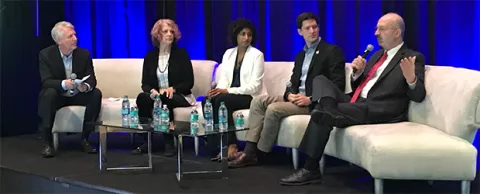
From left-to-right: Council Chairman Jesse Berst, San Leandro CIO Deborah Acosta, San Jose CIO Shireen Sandosham, Seattle CTO Michael Mattmiller, and Philadelphia CIO Charles Brennan
This week, we held our first Smart Cities Week event in the Silicon Valley of California. It’s one of the country’s top areas for technology research, so we asked our smart cities experts to look to the future: What will tomorrow’s cities look like and how do we get there?
From stamping out “zombie” technologies to building regional coalitions, here is some of their valuable advice that will help you make your own efforts more effective. – Kevin Ebi
Charles Brennan, Chief Innovation Officer, Philadelphia
“We are always stretching the boundaries of what we have to maintain,” Brennan said.
While you may be focused on the future, you also have to pay attention to your past. Brennan said one of his biggest struggles is “dead software.” Some of the city’s systems date back 30 years and require the expertise of COBOL programmers to maintain. “Where do I get that skill today?”
Replacing systems isn’t easy and can have unintended consequences. He says old systems are often more zombie-like than elderly. And sometimes, when you think you’ve eliminated the old code in one department, you then realize it’s tied somewhere else.
It’s critical that, as much as possible, you do the research to uncover those ties early in your replacement process.
Shireen Santosham, Chief Innovation Officer, San Jose
It’s far too easy to put technology on the backburner and smart cities make a concerted effort to give it the visibility it deserves. People notice potholes on their streets or crime in their neighborhoods. Technology, however, often disappears into the background.
“Technology just hasn’t been viewed to the level of infrastructure and public safety,” she said. “Now we have to pay off a lot of tech debt in order to catch up.”
How do you avoid falling into that trap? Understand the role that technology can play to improve peoples’ lives in visible ways and make those links clear.
Michael Mattmiller, Chief Technology Officer, Seattle
Do you have a smart cities point person? You need one. It’s easy for city departments to get trapped in silos. A coordinator can help break down those walls.
Mattmiller says Seattle is in the process of hiring a smart cities coordinator, somebody who can go from department to department to get everyone working toward together toward the same goal.
“All of these things need to be brought together with our public in order to make sure that we have a solid plan to move forward,” he said. The person who takes on that job will also “be out in the community to build a public vision of what we want to be as a smart city.”
Deborah Acosta, Chief Innovation Officer, San Leandro
You may have a smart cities roadmap, but if you don’t have a solid data backbone, you aren’t going anywhere. She says too often, cities hire chief innovation officers with high hopes they will be able to achieve radical transformations. But it is the data infrastructure that is often a limiting factor.
“Without that connectivity, you can’t do advanced manufacturing,” she said. “You can’t do machine processing. You can’t do any of the things that will take us to the future of the Internet of Things.”
She also says it’s good to think beyond your city lines. Your issues are often regional issues.
“We are no longer a city that’s in the Silicon Valley area,” Acosta said. “We are of it, participating in it.”



